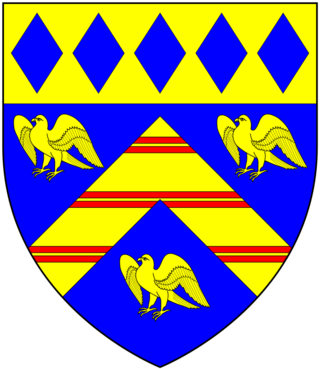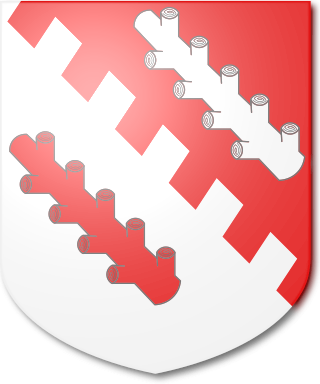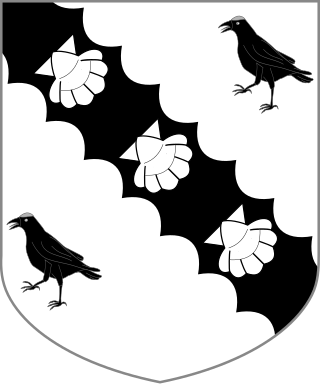
Viscount Hardinge, of Lahore and of Kings Newton in the County of Derby, is a title in the Peerage of the United Kingdom. It was created in 1846 for the soldier and Tory politician Sir Henry Hardinge. His son, the second Viscount, represented Downpatrick in Parliament. His great-great-grandson, the sixth Viscount, succeeded a distant relative as eighth Baronet, of Belle Isle in the County of Fermanagh, in 1986. This title had been created in the Baronetage of the United Kingdom 1801 for Richard Hardinge. He was the third son of Nicolas Hardinge, younger brother of Reverend Henry Hardinge and uncle of the latter's third son Henry Hardinge, 1st Viscount Hardinge. The baronetcy was created with special remainder to the heirs male of Richard Hardinge's father.

Baron Avebury, of Avebury in the County of Wiltshire, is a title in the Peerage of the United Kingdom. It was created 22 January 1900 for the banker, politician and archaeologist Sir John Lubbock, 4th Baronet. He was succeeded by his eldest son, the second Baron. On his death the titles passed to his nephew, the third Baron. He was the son of Harold Fox Pitt Lubbock, fourth son of the first Baron, who died in 1971. The title then passed to the third Baron's first cousin, the fourth Baron, the son of Maurice Fox Pitt Lubbock, sixth son of the first Baron. The fourth baron was a Liberal Democrat politician and one of the ninety excepted hereditary peers who remained in the House of Lords after the passing of the House of Lords Act 1999. He was succeeded by his son, the fifth Baron, in 2016.

Baron Roborough, of Maristow in the County of Devon, is a title in the Peerage of the United Kingdom. It was created on 24 January 1938 for Sir Henry Lopes, 4th Baronet. He had earlier represented Grantham, Lincolnshire, in Parliament as a Conservative. The Baronetcy, of Maristow House in the County of Devon, had been created in the Baronetage of the United Kingdom on 1 November 1805 for Manasseh Masseh Lopes, a member of a wealthy family of Portuguese Jewish origin, with special remainder to his nephew Ralph Franco, son of his sister Maria. Manasseh Masseh Lopes converted to Christianity in 1802, and later represented Evesham, in Worcestershire, Barnstaple in Devon, and Westbury in Somerset, in Parliament. However, in 1819 he was twice convicted of bribing the voters in both Barnstaple and Grampound in order to be elected to Parliament, and was sentenced to imprisonment and heavy fines. He was also unseated by the House of Commons, but after his release from prison he nonetheless got elected for Westbury, a pocket borough which he controlled to a great extent.
The Stronge baronetcy of Tynan was conferred in the Baronetage of the United Kingdom on 22 June 1803. The family were northern Irish landowners of Tynan Abbey, County Armagh, also possessing the residence of Lizard Manor, Aghadowey, County Londonderry.

The Eliott Baronetcy, of Stobs in the County of Roxburgh, is a title in the Baronetage of Nova Scotia. It was created on 3 December 1666 for Gilbert Eliott. The second baronet was a member of the pre-union Parliament of Scotland. The third Baronet sat as Member of Parliament for Roxburghshire. The Eliott Baronets share a common early Elliot ancestry with the nearby Earls of Minto (Elliot). It is thought that the surname spelling differences were contrived to differentiate the branches.

The Strachey baronetcy, of Sutton Court in the County of Somerset, England, is a title in the Baronetage of the United Kingdom. This family was originally seated at Walden, Essex, where William Strachey was living under the rule of Edward VI. Later they moved to Surrey and at last settled at Sutton Court, Somerset. The title was created on 15 June 1801 for the politician and civil servant Henry Strachey. Sir Henry was private secretary to Lord Clive during his last expedition to India in 1764. He also took part in negotiations for peace with North America where he assisted the kings commissioners at Paris. He died in 1809 and was succeeded by his eldest son Henry, the second Baronet Strachey. His great-grandson, the fourth Baronet, was a Liberal politician. On 3 November 1911, he was created Baron Strachie, of Sutton Court in the County of Somerset, in the Peerage of the United Kingdom. He later served as Paymaster General. The peerage became extinct on the death of his son, the second Baron, in 1973. The baronetage is currently dormant.

There have been two baronetcies created for members of the Jessel family, both in the Baronetage of the United Kingdom. One creation is extant as of 2012.
The Adair Baronetcy, of Flixton Hall in the County of Suffolk, was a title in the Baronetage of the United Kingdom. It was created on 2 August 1838 for Robert Adair. He was succeeded by his eldest son, the second Baronet. He sat as Member of Parliament for Cambridge. In 1873 he was created Baron Waveney, of South Elmham in the County of Suffolk, in the Peerage of the United Kingdom. The barony became extinct on his death in 1886 while he was succeeded in the baronetcy by his younger brother, Hugh Adair, the third Baronet. The latter had earlier represented Ipswich in Parliament. Two of his sons, the fourth and fifth Baronets, both succeeded in the title. The fifth Baronet's son, the sixth Baronet, was a major general in the British Army. The title became extinct on the latter's death in 1988.

The Boyle Baronetcy, of Ockham in the Parish of Salehurst in the County of Sussex, is a title in the Baronetage of the United Kingdom. It was created on 14 December 1904 for Edward Boyle, a barrister, businessman and Conservative Member of Parliament for Taunton. His grandson, the third Baronet, was also a Conservative Member of Parliament and ultimately cabinet minister serving as Minister of Education from 1962 to 1964. He was made a life peer as Baron Boyle of Handsworth, of Salehurst in the County of Sussex, in 1970 and became vice-chancellor of the University of Leeds in the same year. The life peerage became extinct on his death in 1981 and he was succeeded in the baronetcy by his younger brother, the fourth Baronet. As of 2024 the title is held by the latter's eldest son, the fifth Baronet, who succeeded in 1983.

The Leeds Baronetcy, of Croxton Park in the County of Cambridge, is a title in the Baronetage of the United Kingdom. It was created on 31 December 1812 for George Leeds. He was an equerry to Prince Augustus Frederick, Duke of Sussex. The Croxton Park estate in Cambridgeshire had been in the Leeds family since circa 1568. As of 2011 the presumed ninth and present Baronet, a resident of Canada, has not successfully proven his succession and is not on the Official Roll of the Baronetage.

The Muir Mackenzie Baronetcy, of Delvine in the County of Perth, is a title in the Baronetage of the United Kingdom. It was created on 9 November 1805 for Alexander Muir Mackenzie. Born Alexander Muir, he had assumed the additional surname of Mackenzie on succeeding to the estates of his great-uncle John Mackenzie, of Delvine, Perthshire, third son of Sir Kenneth Mackenzie, 1st Baronet, of Coul.

The Rycroft Baronetcy, of Calton in the County of York, is a title in the Baronetage of Great Britain. It was created on 22 January 1784 for Reverend Richard Rycroft. Born Richard Nelson, he was the only surviving son of John Nelson, and had assumed by Royal sign-manual the surname of Rycroft in lieu of his patronymic in 1758. The fifth Baronet was high sheriff of Hampshire in 1899. The sixth Baronet was high sheriff of Hampshire in 1938.

The Poore Baronetcy, of Rushall in the County of Wiltshire, is a dormant title in the Baronetage of Great Britain. It was created on 8 July 1795 for John Methuen Poore, with remainder, failing heirs male of his own, to his brother Edward Poore and the heirs male of his body.

The Milman Baronetcy, of Levaton-in-Woodland in the County of Devon, is a title in the Baronetage of Great Britain. It was created on 28 November 1800 for Francis Milman, Physician-in-Ordinary to King George III and President of the Royal College of Physicians. The seventh Baronet was a brigadier-general in the British Army.

The Smith, later Hamilton-Spencer-Smith, later Spencer-Smith Baronetcy, of Tring Park in the County of Hertford, is a title in the Baronetage of the United Kingdom. It was created on 11 June 1804 for Drummond Smith, with remainder to the heirs male of his niece Augusta, wife of Charles Smith, MP, of Suttons, Essex. The latter was a descendant of Robert Smith, of Ilminster, from whom the Smith-Marriott baronets are also descended. The fifth Baronet, was a member of the Military Inter-Allied Commission of Control from 1920 to 1924. The sixth Baronet discontinued the use of the surname of Hamilton.

The Metcalfe Baronetcy, of Chilton in the County of Berkshire, was a title in the Baronetage of the United Kingdom. It was created on 21 December 1802 for Thomas Metcalfe, Member of Parliament for Abingdon between 1796 and 1807.

The Astley, later Astley-Corbett, later Astley Baronetcy, of Everley in the County of Wiltshire, was created in the Baronetage of the United Kingdom on 15 August 1821 for John Astley, Member of Parliament for Wiltshire and Wiltshire North. He was a descendant of Thomas Astley, younger brother of the first Baronet of Patshull. The third Baronet represented Lincolnshire North in Parliament as a Conservative. He married Eleanor Blanche Mary, daughter of Thomas George Corbett. Their eldest son, Francis, the fourth Baronet, assumed by Royal licence the additional surname of Corbett in 1890. His grandson, Francis, the fifth Baronet, was killed in action in World War II.
The Vavasour Baronetcy, of Hazlewood in the County of York, was created in the Baronetage of the United Kingdom on 14 February 1828 for Edward Vavasour. He was the third son of Charles Stourton, 17th Baron Stourton, and the maternal cousin of the seventh and last Vavasour Baronet of the 1628 creation. He succeeded to the Vavasour estates and assumed by Royal licence the surname of Vavasour.
The Sullivan baronetcy, of Thames Ditton in the County of Surrey, was created in the Baronetage of the United Kingdom on 22 May 1804 for the writer and MP Richard Sullivan. The third and sixth Baronets were Admirals in the Royal Navy. The ninth holder of the baronetcy did not use his title; as of 2023 the Official Roll marked the baronetcy as vacant.

The Rowley baronetcy, of Hill House in the County of Berkshire, was created in the Baronetage of the United Kingdom on 21 March 1836 for the naval commander Admiral Charles Rowley. He was the fourth son of the 1st Baronet of the 1786 creation.

















